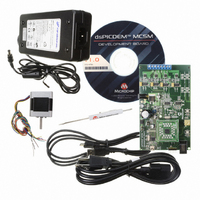DV330021 Microchip Technology, DV330021 Datasheet - Page 18

DV330021
Manufacturer Part Number
DV330021
Description
BOARD DEV DSPICDEM MCSM KIT
Manufacturer
Microchip Technology
Series
dsPIC™r
Datasheet
1.DM330022.pdf
(38 pages)
Specifications of DV330021
Main Purpose
Power Management, Motor Control
Embedded
*
Utilized Ic / Part
dsPIC33F
Primary Attributes
*
Secondary Attributes
*
Processor To Be Evaluated
dsPICDEM
Processor Series
dsPIC DSC
Interface Type
USB
Operating Supply Voltage
24 V
Silicon Manufacturer
Microchip
Silicon Core Number
DsPIC33F
Core Architecture
PIC
Core Sub-architecture
PIC33
Silicon Family Name
Piccolo
Lead Free Status / RoHS Status
Lead free / RoHS Compliant
Lead Free Status / RoHS Status
Lead free / RoHS Compliant, Lead free / RoHS Compliant
Available stocks
Company
Part Number
Manufacturer
Quantity
Price
Company:
Part Number:
DV330021
Manufacturer:
MICROCHIP
Quantity:
12 000
dsPICDEM™ MCSM Development Board User’s Guide
FIGURE 3-2:
DS70610A-page 18
PWM1H1
PWM1H2
PWM1L1
PWM1L2
3.1.1
The dsPICDEM MCSM Development Board features two full-bridge inverters to accom-
modate a bipolar stepper motor. MOSFET gate signals are powered from a 15V per-
manent supply while the full-bridge inverters can be powered from a supply up to 80V.
3.1.1.1
Although the dsPIC DSC devices can operate in Complementary PWM mode,
Independent PWM mode is still possible. In this case, internal dead time control and
shoot-through protection circuits are disabled. In order to protect the power stage from
high shoot-through currents in Independent PWM mode, the chosen MOSFET driver
also has a built-in shoot-through protection and a small fixed dead time. In Independent
PWM mode, the development board is suitable for controlling two brushed DC motors
with full direction control, or up to four DC motors with a single turning direction.
3.1.1.2
Driving a stepper motor in a full-bridge topology requires switching the opposite
diagonal MOSFETs on and off at the same time in order to reverse the drive current
and to accommodate all possible decay modes. Since all PWMxHx pins are on at the
same time (for example, PWM1H1 and PWM1H2), it is not possible to drive all of the
high-side MOSFETs with the PWMxHx signals. Figure 3-2 shows the PWM and
MOSFET assignment.
Driving the high PWM pins active will run the current through a motor winding in one
direction, while driving the low PWM pins active will run the current through the winding
in the opposite direction. By using this topology in addition to the dsPIC PWM Override
feature, all decay modes for the winding current can be achieved.
Refer to Appendix A. “Board Layout and Schematics” for the complete schematic
and PWM pin assignments.
MOSFET PWM ASSIGNMENT
T1
T2
Power Stage
MOSFET DRIVER
SWITCHING TOPOLOGY
T1
T1
© 2009 Microchip Technology Inc.
T2












